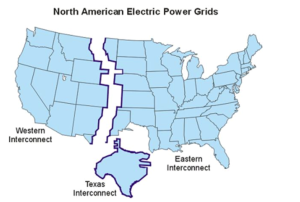INFRASTRUCTURE
The national electric power grid is the transmission infrastructure used for wind energy. The power grid is the nationwide electrical system that connects electricity producers with consumers, using transmission and distribution lines, as well as related facilities. In the U.S., local electricity grids are interconnected to form larger, more reliable networks. The power system in the lower 48 states is comprised of three main interconnections which operate mostly independently from one another (there are limited transfers of electricity between these three networks). The three primary networks include the Eastern Interconnection (includes the area east of the Rocky Mountains, and a portion of the Texas panhandle), Western Interconnection (includes the area from the Rockies to the west), and the Electric Reliability Council of Texas (ERCOT), which covers most of Texas. The Eastern and Western Interconnections are also linked with the Canadian power grid.[1]

Source: EPA
In 2021, net generation of electricity from utility-scale generators in the United States was about 4,116 billion kilowatthours (kWh) (or about 4.12 trillion kWh).[2] According to EIA, “the U.S. electric transmission network consists of about 700,000 circuit miles of lines” [3] and more than 7,300 power plants.[4] As of December 31, 2020, there were 23,417 electric generators at about 11,070 utility-scale electric power plants in the United States.[5] Nationally, wind turbines yielded 8.4% of utility-scale electricity generation in 2020.[6]
More wind-powered electricity generation is a result of the growth in the installed capacity of wind turbines in the United States. The third-largest source of generating capacity in the United States is wind turbines. Wind penetration represents the share of electric demand satisfied by wind generation.[7]
However, the age of the U.S. grid hinders progress as the U.S. seeks to increase access to renewable energy sources. Recent studies show that as much as 70 percent of the grid's power transformers and transmission lines are over 25 years old. The current infrastructure requires a critical investment in order to accelerate the shift toward clean power. In 2021, Congress enacted the Infrastructure Investment and Jobs Act (IIJA), which the President signed, in an effort to address these challenges. The IIJA provides new tools and funding to the Department of Energy to accelerate the expansion and modernization of the Nation's electric grid. Transmission projects require large, upfront investments. The IIJA requires states to incorporate transmission planning as a mandatory feature of their energy plans and is supported with $500 million in increased funding for the State Energy Program. A new $2.5B revolving fund was established by the IIJA to facilitate the construction of high capacity new, replacement, or upgraded transmission lines.[8]
In April 2021, WhiteHouse.gov cited a report that projects around 600,000 new jobs would be created by the American Jobs Plan, including 240,000 direct jobs plus 360,000 indirect and induced jobs. More than 20 transmission projects are positioned to move from an advanced planning stage into construction. The $33 billion investment would also enable wind and solar deployment, which could potentially create an additional 640,000 jobs, bringing the total job creation benefit to around 1,240,000 jobs.[9]
Read the bipartisan Infrastructure Investment and Jobs Act (H.R. 3684) which details the new spending on the nation’s infrastructure, including in the energy grid.
Updated January 2024 by Jennfier Ostromecki

Comments are closed.